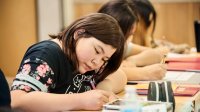4 Steps to Get Middle School Students Excited About Revision
When the revision process is scaffolded, students learn that writing multiple drafts can be fun and will lead to better writing.
Your content has been saved!
Go to My Saved Content.When I first started teaching writing to middle school students, I found that some of them handed in final writing pieces that had few major revisions to the original draft. I wanted to figure out a way to bring an element of playfulness to the writing process, where creating multiple versions of parts of a writing piece was not a laborious task but instead one that sparked excitement and creativity. Most important, I wanted students to see the benefit of playing around with different ideas and to witness their own growth as writers in the process.
Over time, I’ve developed a method of approaching the writing process that inspires students to take creative risks in their writing, builds relationships, and deeply enhances their finished pieces and reflections. Here are the four steps.
1. Self-Discovery Using Authentic Text
Jean Piaget, a psychologist who focused on child development, once said, “Each time one prematurely teaches a child something he could have discovered himself, that child is kept from inventing it and consequently from understanding it completely.”
When I first came across this quote, I had a lightning moment of connection. It put into words what I had been noticing in my language arts classroom all along: When students are given the chance to explore an idea, it creates excitement and engagement throughout the process.
No matter which writing unit my students are working through, I’ve found that purposely focusing on one area of the piece at a time is ideal. Let’s say we’re workshopping how to create powerful introductions in narrative writing. I’ll prompt students: “Open up to a few different chapters of your current book. How did the author begin each of those chapters? What stands out to you? Which are your favorite chapter openings? Why?”
Students will analyze the text, jotting down their observations on a sticky note, and share with their small groups. Then, as a class, we’ll create a list of engaging ways that authors began chapters. Students might share observations like these:
- Character details
- Setting description
- Dialogue
- A short, powerful sentence or word
- An action
- A question
- Flash forward or flashback
- A reflection
As students are contributing, I’ll record their names next to each idea, which prompts greater participation and validates their thinking. Allowing students the opportunity to discover these examples themselves gives them ownership over the process and creates a fun, collaborative energy in the room.
2. Friendly Debate Using Teacher Models
The next day, I’ll use the student idea list to craft three different model introduction paragraphs, using as many of the strategies they had noticed as possible.
After reading them, students will each vote for their favorite one. This always results in mixed opinions. Students will each share why they chose the one they did, which often leads to enthusiastic discussions.
I’ll hear things like “The first one is the best because it’s short and gets right to the point” or “I like the third one the best because she used imagery I could really picture. I like the creative words and how the sentences connect well” or “The second one drew me in because it was suspenseful and it made me want to read more.” This is when it really clicks for students that writing more than one version can help their own writing as well.
This leads me to begin a conversation on the artistry of writing. I’ll say, “Imagine if I had only written the first introduction paragraph. So many of you liked the second and third ones. As writers, we are artists, and artists often create multiple versions of a piece to discover their best.”
I’ll then model for students how sometimes I can take parts I really like from two or more of the paragraphs and fuse them together to create an entirely new one.
3. Students Create Multiple Versions
I’ll provide students with the class list of intro ideas they created, and they’ll put a star next to ones they’d like to try out in their own writing. After sharing their thinking with a partner, they’ll craft several different opening paragraphs. Once done, students will read them to their small group. Each student will share which was their favorite and why, and also offer constructive feedback.
I’ll then say to students, “Now that you’ve gotten your peers’ perspectives on your work, you get to decide which one you’ll publish. Which one presses on your heart the most? Which one will best engage your readers?” Sometimes I’ll hear, “I can’t pick! I’m making a hybrid model!” which means a student has decided to use parts of more than one sample introduction paragraph.
4. Fine-Tuning
Before students peer-edit their paragraphs with a partner, I’ll have a few volunteers display and read their work to the class to model meaningful editor and writer conversations. During this time, the class will act as editors and share the lines that stood out to them as powerful, questions that have arisen, and areas for growth. Many students love the opportunity to receive feedback from so many students at once, and I’ve found that modeling helps deepen conversations and peer-editing expectations, so students do more than just scan for punctuation and spelling errors.
After the writing process, students will reflect on their journey. Many students have expressed how much they enjoyed seeing how diverse their writing could be and how much they liked getting their peers’ feedback on multiple samples. As a teacher, I find it powerful to see the evolution of students’ work, knowing that they unlocked the secrets to great writing on their own and then had the chance to explore the many routes their writing could take.
